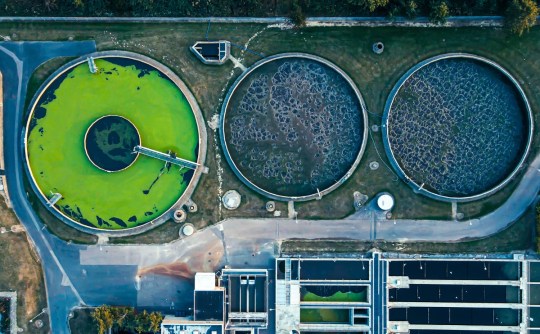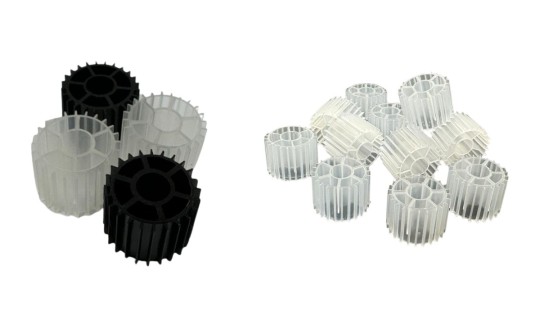Bioflow provides end-to-end solutions with specially engineered products for water and waste water treatment, cooling tower components and water stopping solutions.
Don't wanna be here? Send us removal request.
Text
Is Your STP Underperforming? Your MBBR Media Could Be the Real Problem
Sewage treatment plants (STPs) often fail to meet discharge standards, not because of flawed designs or operator inefficiencies, but due to substandard MBBR (Moving Bed Biofilm Reactor) media. In many cases, poor-quality media leads to a range of operational issues that compromise treatment performance and regulatory compliance.

Some of the most common symptoms include:
Inadequate BOD/COD reduction
Excessive sludge accumulation
Clogging in aeration tanks
Repeated loss of biofilm
These problems often indicate that the MBBR media in use may not be delivering the efficiency required for stable biological treatment.
The Overlooked Element in STP Performance
The core efficiency of any MBBR-based system lies in the quality and performance of the media used. When media are poorly designed, made of inferior materials, or lack sufficient surface area, they fail to support adequate biofilm development. This results in inconsistent pollutant breakdown and unstable operation.
In addition, media that float irregularly, clump together, or settle improperly cause dead zones and disrupt aeration. These conditions directly impact oxygen transfer, reduce contact time, and lower treatment efficiency. On the other hand, well-engineered media ensure uniform distribution, optimal mixing, and effective biological loading.
Key Characteristics of High-Performance MBBR Media
To maintain optimum treatment levels, MBBR media should meet specific technical standards. The most effective biofilm carriers offer the following properties:
Uniform shape and balanced buoyancy
Surface area of 500–600 m²/m³ or more for enhanced microbial attachment
Non-clogging geometry to maintain fluidization
Manufactured from virgin PP or PE polymers for chemical and mechanical durability
These features not only extend the operational lifespan of the media but also ensure consistent and efficient pollutant removal under varying load conditions.
Benefits of Upgrading to Quality MBBR Media
Switching to high-quality MBBR media can deliver measurable improvements in plant efficiency. Operators can expect:
Consistent achievement of PCB discharge norms
Better treated water output with reduced chemical dosing
Enhanced aeration efficiency leading to lower power consumption
Fewer maintenance issues and reduced operational downtime
Across industrial and municipal setups, upgrading to advanced media has proven to increase BOD and COD removal rates, stabilize nitrogen reduction, and improve compliance with environmental standards.

Why MBBR Media Quality Is Critical
1. Surface Area Drives Treatment Efficiency
The larger the effective surface area, the more biofilm can grow, enabling robust breakdown of organic pollutants.
2. Proper Hydrodynamics Ensure Oxygen Distribution
Media must maintain fluidized motion to allow even oxygen transfer throughout the reactor. Inconsistent buoyancy leads to stagnant zones and performance loss.
3. Material Quality Impacts Longevity
Low-cost, recycled materials often degrade faster, resulting in deformation, fragmentation, and reduced treatment efficiency. Virgin polymers offer longer operational life and greater resistance to chemical attack.
4. Regulatory Pressure Demands Precision
With stricter limits on BOD, COD, TSS, and nutrient discharge, STPs cannot afford media that underperform or deteriorate prematurely.
Types of MBBR Media and Their Applications
Different types of MBBR media are suited for various treatment needs:
K1 Media (10x7 mm) – Compact and ideal for systems requiring high turbulence
MBBR Media 16x22 mm – Widely used in domestic and industrial STPs for balanced performance
FAB Media – Suitable for both aerobic and anaerobic treatment zones due to high surface area
Recycled MBBR Media – Economical, but generally lower in strength and efficiency
Virgin PP/PE Media – Preferred for high-load systems due to superior durability and reliability
Choosing the correct media type based on plant size, load capacity, and treatment objectives is essential for optimal performance.
Signs of Low-Quality MBBR Media
Identifying poor media early can prevent long-term operational setbacks. Key warning signs include:
Discoloration or brittleness – Often a sign of inferior polymer quality
Irregular or sinking behavior – Leads to poor mixing and dead zones
Limited or uneven surface area – Reduces biofilm stability
Frequent media damage or fragmentation – Causes blockages and unplanned maintenance
Unpleasant odors or foam formation – Indicates inefficient biofilm activity or detachment
When these symptoms are present, media replacement becomes necessary to restore normal plant function.
Recommended Process for MBBR Media Upgrade
A strategic approach ensures minimal disruption during media replacement:
Evaluate Existing Media Inspect for damage, buoyancy issues, and wear.
Calculate Media Requirements Determine volume and surface area based on daily flow and organic load.
Choose the Right Media Select types with adequate surface area and non-clogging design for your plant configuration.
Implement in Phases Introduce new media gradually to support biofilm adaptation.
Monitor Performance Track parameters like BOD, COD, DO, and sludge behavior after installation.
Conclusion
MBBR media serve as the backbone of biological wastewater treatment systems. Their design, durability, and effectiveness directly influence plant efficiency, energy use, and regulatory compliance. Investing in high-quality media not only enhances treatment performance but also extends the lifespan of the entire STP infrastructure.
At Bioflow Industries, we are recognized as a leading manufacturer of all types of MBBR media. Our products are engineered to offer high surface area, uniform performance, and long-lasting results across varied wastewater treatment applications.
1 note
·
View note